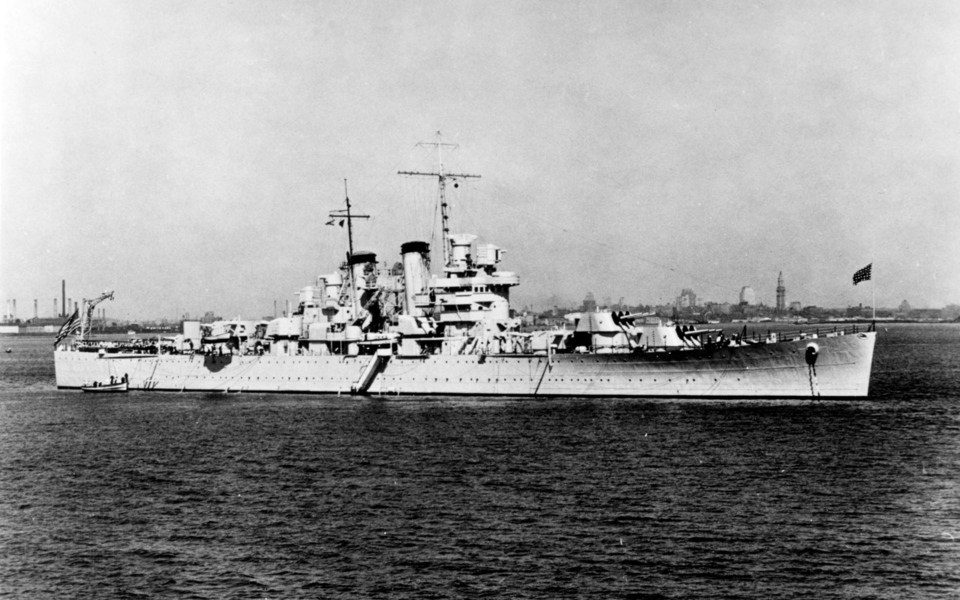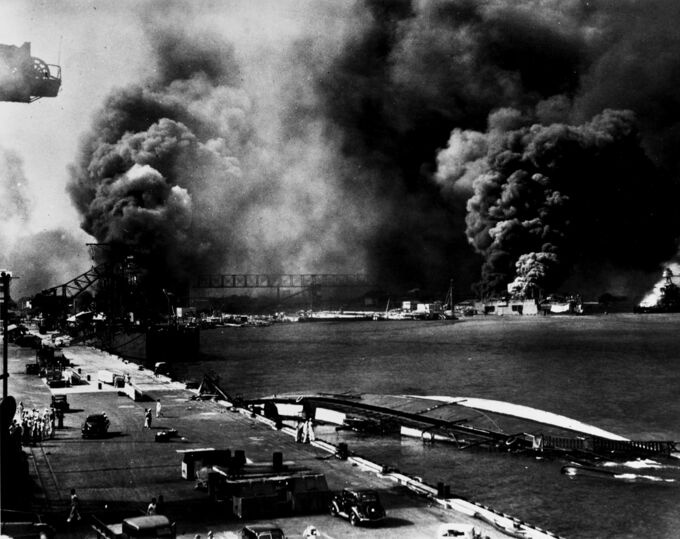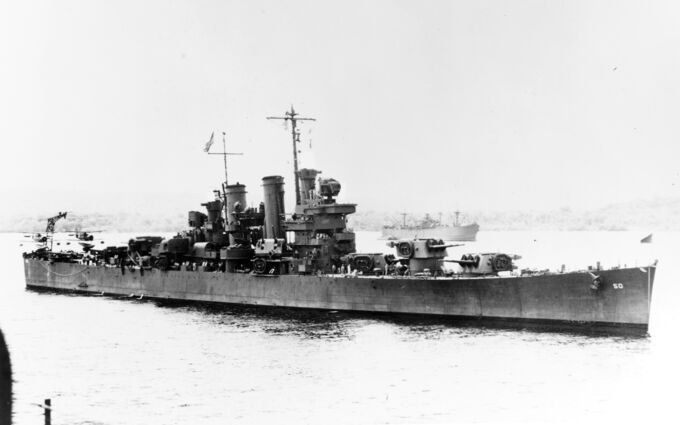The Brooklyn-class light cruisers, built in the early 1930s, were the first American cruisers built to the specifications of the London Naval Treaty. They were designed to counter the Japanese Mogami class and featured a similar armament of fifteen 6-inch guns. Helena was completed to an altered design featuring improved machinery protection and greatly improved anti-aircraft armaments. She was torpedoed during the attack on Pearl Harbor, repaired, and returned to service. She saw extensive action and managed to damage or sink several Japanese ships during the Battles of Guadalcanal, but was sunk during the Solomons campaign when she was torpedoed by Japanese destroyers.
Design and development
As the London Naval Treaty limited the amount of heavy cruisers with 8-inch main armament, American naval designers decided to create a ship displacing 10,000 tons with a 6-inch main armament. Additionally, they found that a light cruiser with a 6-inch main armament could overwhelm a comparable heavy cruiser due to their higher fire rate. As a result, the designers pushed forward with a new 6-inch armament light cruiser: the Brooklyn class.
However, during Brooklyn's design process, it was discovered that the Japanese intended to arm their new Mogami class with fifteen 6-inch guns. As a result, the Brooklyn's design was amended to include an additional 3-gun turret mounted in a rear-facing non superfiring position. Helena was initially built to this design and was launched in August 1938. However, she featured a revised machinery layout which improved her survivability, as well as a revised secondary armament of eight 5-inch/38 guns in dual enclosed mounts. Her anti-aircraft armament was initially unchanged but was refitted significantly later on during the war.
Helena was 185 m long and displaced exactly 10,000 tons standard, and 13,300 tons full. She had a main armament of fifteen 6-inch (152 mm) guns in five triple turrets, three fore and two aft. The #3 turret, mounted ahead of the superstructure, faced backwards and was unable to fire forwards. Her secondary armament consisted of the 5-inch (127 mm) guns, and her anti-aircraft armament initially consisted of eight 12.7 mm AN/M2 machine guns. Later on, these would be augmented by several quadruple 28 mm "Chicago Pianos", and then replaced entirely with a heavy anti-aircraft suite of 40 mm Bofors and 20 mm Oerlikon cannons. Her engines delivered a total of 100,000 shaft horsepower (shp), allowing her a top speed of 32.5 knots (60 km/h).
Operational history
Helena was commissioned in December 1939, after the start of the Second World War. Due to the neutrality of the United States, Helena participated in training exercises for most of 1939, 1940 and 1941. She sailed to Montevideo, Uruguay, to inspect the wreck of the German pocket battleship Admiral Graf Spee, and then proceeded through the Panama Canal to join the Pacific Fleet. She was docked in the position normally reserved for the battleship Pennsylvania in December 1941, as the battleship had been dry-docked for repairs.
Pearl Harbor
On December 7th, 1941, the Japanese fleet attacked Pearl Harbor with a massive aerial attack. A pilot from the first wave mistook Helena for Pennsylvania and hit her with a torpedo which caused severe damage. Despite this, the crews closed off flooded compartments and turned on the auxiliary generators, which allowed her 5-inch guns to return fire against the enemy. During this time, four other torpedo bombers attempted to hit the cruiser, but all missed. The second wave of bombers had worse luck due to the determined anti-aircraft fire that the cruiser provided: at least four bombs missed, and Helena was credited with shooting down six aircraft out of the 29 aircraft shot down in total by American forces.
Helena was given temporary repairs and sailed for Mare Island in California for more complete repairs. There, she was given a new superstructure, and her anti-aircraft armament was completely redone. Her old 1.1-inch (28 mm) and 12.7 mm guns were removed and replaced with a combination of 16 40 mm Bofors guns and numerous 20 mm Oerlikons. After the completion of repairs, Helena sailed back to the Pacific to participate in the Guadalcanal campaign.
Guadalcanal campaign
After arriving in the Guadalcanal theatre, Helena joined a cruiser force tasked with destroying enemy ships in the Guadalcanal area. She soon saw her first combat action during the night of October 12, 1942, when the force spotted a Japanese bombardment unit composed of the cruisers Furutaka, Aoba, Kinugasa, and several accompanying destroyers; this action was to be known as the battle of Cape Esperance. Helena, along with the other cruisers, opened fire at 5 km range, at a point where the Japanese force were completely unaware of the American force. Helena, along with the other cruisers, were successful in hitting the Furutaka and destroyer Fubuki multiple times. Both ships were eventually destroyed later in the night.
After the battle of Cape Esperance, Helena was attached to a heavy unit tasked with defending an American convoy bound for the beaches of Guadalcanal. They arrived on November 12th, and Helena covered the landings. However, a Japanese force, centred on the fast battleships Hiei and Kirishima, was also approaching with the intention of shelling the American troops. As a result, these two forces collided in a battle known as the Naval Battle of Guadalcanal.
The ships encountered each other at close range, causing confusion among the American units. In the following engagement, Helena engaged the destroyer Akatsuki, which was then engaged by multiple vessels and sank. She then hit the destroyers Amatsukaze, Murasame, and Samidare with 6-inch rounds, causing heavy damage. However, during this time, the flagship San Francisco had been hit by multiple heavy rounds from the battleship Hiei, and Helena rushed to protect her. In the following engagement, two American destroyers were sunk and 4 more ships heavily damaged; Helena herself emerged relatively unscathed. The Japanese squadron lost the battleship Hiei, as well as two destroyers. The surviving ships of the battered squadron retreated to the southeast; during this time, the cruiser Juneau was hit by a torpedo launched from the submarine I-26 which exploded her magazines and caused her to sink; however, Helena did not stop to pick up survivors as the squadron's commanding officer deemed her to be too precious to risk (since there was a submarine in the area).
Later service
In January 1943, the Helena was assigned to a new unit to attack Japanese positions in the New Georgia campaign. During this time, her 5-inch guns received new HE-VT shells, which she fired as the first use of the proximity-fused shell in American service. She served extensively as a fire support ship, firing thousands of high-calibre shells in support of American troops.
Sinking
On July 4th, 1943, Helena was part of an invasion squadron to land troops at Rice Anchorage. She proceeded to bombard the Japanese positions under cover of darkness along with the other cruisers and destroyers, but her shell flashes alerted a force of three Japanese destroyers who had been tasked with landing reinforcements for the Japanese garrison. The destroyers withdrew, not before they launched 24 Type 93 Long Lance torpedoes at the Americans. Helena was not hit, but a destroyer was sunk and the convoy turned to avoid what was believed to be a submarine (the Americans failed to sight the Japanese destroyers). During this time, Helena's #2 ammunition hoist broke down and her #5 guns suffered a jam. These issues were resolved as she steamed towards the Kula Gulf.
The next night, the Japanese force returned with 10 destroyers, intending to land the troops again. The American force closed in, and soon after, the Japanese force detected the American squadron using their radar. The Japanese force then began a determined attack with gunfire and torpedoes while the Americans fired back. In the course of 3 minutes, Helena, along with her other cruisers, fired over 1,500 6-inch rounds at the enemy. The destroyer Niizuki was sunk, and the Americans turned right to follow the fleeing Japanese destroyers.
However, shortly after the initial engagement, Helena was hit by a torpedo launched by the Japanese destroyers. The torpedo caused extensive damage and exploded the forward magazines, ripping her bow off the ship. However, she continued to steam forward at 25 knots. Soon after, she was hit by an additional pair of torpedoes deep under the waterline which broke her keel and flooded the machinery spaces - with no power, the order was given to abandon ship. Soon after, the broken keel caused Helena to break into three parts - the midsection sank quickly while the stern and bow remained afloat.
At this point, the American force had not yet realised that the Helena was destroyed - however, after failing to contact her, they found her wreck and rescued many survivors from the water. Over 100 men were not rescued and ended up on a Japanese-occupied island, where they were protected by coastwatchers and eventually rescued on July 15th. Helena's name was carried on by a Baltimore-class cruiser launched in 1945; her wreck was eventually located in 2018 by an expedition carried out by the late Microsoft founder Paul Allen.



